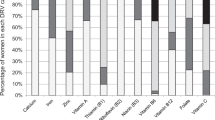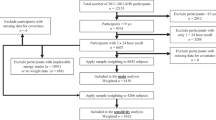Abstract
Background/Objectives:
Breakfast is an important source of micronutrients in the diet and its consumption has been linked to positive health outcomes. The present analysis investigated the contribution that breakfast cereals make to the nutrient intakes of the materially deprived (low income) UK population.
Subjects/Methods:
Data for 3728 respondents aged 2 years and over from the UK Low Income Diet and Nutrition Survey (2003–2005) were analysed. Nutrient intakes of consumers and non-consumers of breakfast cereal were compared.
Results:
Breakfast cereals were consumed by 49% of men, 58% of women, 80% of boys and 80% of girls, and median intakes were: 35, 25, 29 and 21 g/d, respectively. Consumers of breakfast cereals had higher intakes of thiamin, riboflavin, niacin, biotin, folate, vitamin B6, vitamin B12, iron and zinc than non-consumers. Breakfast cereal consumption was also related to higher intakes of calcium, attributable to higher milk consumption. The intake of wholegrain and high-fibre breakfast cereals was associated with a higher intake of non-starch polysaccharides. Intakes of niacin, biotin, calcium and zinc were higher but that of vitamin B6 was lower among consumers of exclusively wholegrain and high-fibre breakfast cereals compared with consumers of other breakfast cereals. There were no significant differences observed in intakes of non-milk extrinsic sugars according to type of breakfast cereal consumed.
Conclusions:
Breakfast cereals make a significant contribution to the micronutrient intake of the low-income UK population.
This is a preview of subscription content, access via your institution
Access options
Subscribe to this journal
Receive 12 print issues and online access
$259.00 per year
only $21.58 per issue
Buy this article
- Purchase on Springer Link
- Instant access to full article PDF
Prices may be subject to local taxes which are calculated during checkout
Similar content being viewed by others
References
Albertson AM, Thompson D, Franko DL, Kleinman RE, Barton BA, Crockett SJ (2008). Consumption of breakfast cereal is associated with positive health outcomes: evidence from the National Heart, Lung, and Blood Institute Growth and Health Study. Nutr Res 28, 744–752.
Barton BA, Eldridge AL, Thompson D, Affenito SG, Striegel-Moore RH, Franko DL et al. (2005). The relationship of breakfast and cereal consumption to nutrient intake and body mass index: The National Heart, Lung and Blood Institute Growth and Health Study. J Am Diet Assoc 105, 1383–1389.
Bates B, Lennox A, Swan G (2009). National Diet and Nutrition Survey. Headline Results from Year One of the Rolling Programme (2008/2009). London.
Crawley HF (1993). The role of breakfast cereals in the diets of 16–17-year-old teenagers in Britain. J Hum Nutr Diet 6, 205–216.
Deshmukh-Taskar PR, Nicklas TA, O'Neil CE, Keast DR, Radcliffe JD, Cho S (2010). The relationship of breakfast skipping and type of breakfast consumption with nutrient intake and weight status in children and adolescents: The National Health and Nutrition Examination Survey 1999–2006. J Am Diet Assoc 110, 869–878.
Emmett PM, Symes CL, Heaton KW (1993). The contribution of breakfast cereals to non-starch polysaccharide intakes in English men and women. J Hum Nutr Diet 6, 217–222.
Finch S, Doyle W, Lowe C, Bates CJ, Prentice A, Smithers G et al. (1998). National Diet and Nutrition Survey: People Aged 65 Years and Over. Volume 1: Report of the Diet and Nutrition Survey. TSO: London.
Galvin M, Kiely M, Flynn A (2002). Impact of ready-to-eat breakfast cereal (RTEBC) consumption on adequacy of micronutrient intakes and compliance with dietary recommendations in Irish adults. Public Health Nutr 6, 351–363.
Gibson S (1999). Breakfast cereal consumption in young children: associations with non-milk extrinsic sugars and caries experience: further analysis of data from the UK National Diet and Nutrition Survey of children aged 1.5–4.5 years. Public Health Nutr 3, 227–232.
Gibson S (2003). Micronutrient intakes, micronutrient status and lipid profiles among young people consuming different amounts of breakfast cereals: further analysis of data from the National Diet and Nutrition Survey of Young People aged 4 to 18 years. Public Health Nutr 6, 815–820.
Gibson SA, Boyd A (2009). Associations between added sugars and micronutrient intakes and status: further analysis of data from the National Diet and Nutrition Survey of Young People aged 4 to 18 years. Br J Nutr 101, 100–107.
Gibson SA, O'Sullivan KR (1995). Breakfast cereal consumption patterns and nutrient intakes of British schoolchildren. J R Soc Promot Health 115, 366–370.
Gregory J, Foster K, Tyler H, Wiseman H. (1990). The Dietary and Nutritional Survey of British Adults. HMSO: London.
Gregory JR, Collins DL, Davies PSW, Hughes JM, Clarke PC (1995). National Diet and Nutrition Survey: Children Aged 1.5 to 4.5 Years. Volume 1: Report of the Diet and Nutrition Survey. HMSO: London.
Gregory JR, Lowe S, Bates CJ, Prentice A, Jackson LV, Smithers G et al. (2000). National Diet and Nutrition Survey: Young People Aged 4 to 18 Years. Volume1: Report of the Diet and Nutrition Survey. TSO: London.
Henderson L, Gregory J, Swan G (2002). National Diet and Nutrition Survey: Adults Aged 19 to 64 years. Volume 1: Types and Quantities of Food Consumed. TSO: London.
Henderson L, Gregory J, Irving K, Swan G (2003a). National Diet and Nutrition Survey: Adults Aged 19 to 64 Years. Volume 2: Energy, Protein, Carbohydrate, Fat and Alcohol Intake. TSO: London.
Henderson L, Irving K, Gregory J, Bates CJ, Prentice A, Perks J et al. (2003b). National Diet and Nutrition Survey: Adults Aged 19 to 64 years. Volume 3: Vitamin and Mineral Intake and Urinary Analytes. TSO: London.
Keski-Rahkonen A, Kaprio J, Rissanen A, Virkkunen M, Rose RJ (2003). Breakfast skipping and health-compromising behaviors in adolescents and adults. Eur J Clin Nutr 57, 842–853.
Kirk TR, Burkill S, Cursiter M (1997). Dietary fat reduction achieved by increasing consumption of a starchy food-an intervention study. Eur J Clin Nutr 51, 455–461.
Lattimore PJ, Halford JCG (2003). Adolescence and the diet-dieting disparity: healthy food choice or risky health behaviour? Br J Health Psychol 8, 451–463.
McNulty H, Eaton-Evans J, Cran G, Woulahan G, Boreham C, Savage J et al. (1996). Nutrient intakes and impact of fortified breakfast cereals in schoolchildren. Arch Dis Child 75, 474–481.
McNulty H, Eaton-Evans J, Woulahan G, Strain JJ (1994). The contribution of breakfast to daily micronutrient intakes of adults in Great Britain (abtract). Proc Nutr Soc 53, 251.
Merten MJ, Williams AL, Shriver LH (2009). Breakfast consumption in adolescence and young adulthood: parental presence, community context, and obesity. J Am Diet Assoc 109, 1384–1391.
Moore GF, Tapper K, Murphy S, Lynch R, Raisanen L, Pimm C, Moore L (2007). Associations between deprivation, attitudes towards eating breakfast and breakfast eating behaviours in 9–11-year-olds. Public Health Nutr 10, 582–589.
Moshfegh AJ, Borrud LG, Perloff B, LaComb RP (1999). Improved method for the 24-h dietary recall for use in national surveys [abstract]. FASEB J 13, A603.
National Diet and Nutrition Survey (NDNS) (2003). Adults Aged 19 to 64 Years. Technical Report c)Appendices. TSO: London.
Nelson M, Atkinson M, Meyer J (1997). Food Portion Sizes: a Photographic Atlas of Food Portion Sizes. Food Standards Agency: London.
Nelson M, Dick K, Holmes B, Dowler E, Thomas R (2003) Low Income Diet Methods Study. Food Standards Agency: London.
Nelson M, Erens B, Bates B, Church S, Boshier T (2007). Low Income Diet and Nutrition Survey. TSO: London. Available at http://www.food.gov.uk.
Nicklas T, O'Neil C, Berenson G (1998). Nutrient contribution of breakfast, secular trends, and the role of ready-to-eat cereals: a review of data from the Bogalusa Heart Study. Am J Clin Nutr 67, 757S–763S.
Nicklas TA, Bao W, Webber LS, Berenson GS (1993). Breakfast consumption affects adequacy of total daily intake in children. J Am Diet Ass 93, 886–891.
Nicklas TA, Myers L, Berenson GS (1995). Total nutrient intake and ready-to-eat cereal consumption of children and young adults in the Bogalusa Heart Study. Nutr Rev 53, S39–S45.
Nicklas TA, O'Neil C, Myers L (2004). The importance of breakfast consumption to nutrition of children, adolescents and young adults. Nutr Today 39, 30–39.
Nicklas TA, Reger CMS, Myers L, O'Neil CE (2000). Breakfast consumption with and without vitamin-mineral supplement use favorably impacts daily nutrient intake of ninth-grade students. J Adolesc Health 27, 314–321.
O'Dea JA, Caputi P (2001). Association between socioeconomic status, weight, age and gender, and the body image and weight control practices of 6- to 19-year-old children and adolescents. Health Educ Res 16, 521–532.
Ofcom (2006). Television Advertising of Food and Drink Products to Children. Ofcom: London http://stakeholders.ofcom.org.uk/consultations/foodads_new/summary. Accessed 23 March 2011.
Pereira MA, Erickson E, McKee P, Schrankler K, Raatz S, Lytle L, Pellegrini A (2011). Breakfast frequency and quality may affect glycemia and appetite in adults and children. J Nutr 141, 163–168.
Rampersaud GC, Pereira MA, Girard BL, Adams J, Metzl JD (2005). Breakfast habits, nutritional status, body weight, and academic performance in children and adolescents. J Am Diet Ass 105, 743–760.
Ruxton CHS, Kirk TR (1997). Breakfast: a review of associations with measures of dietary intake, physiology and biochemistry. Br J Nutr 78, 199–213.
Ruxton CHS, O'Sullivan KR, Kirk TR, Beltons NR (1996). The contribution of breakfast to the diets of a sample of 136 primary-schoolchildren in Edinburgh. Br J Nutr 75, 419–431.
Sjoberg A, Hallberg L, Hoglund D, Hulthen L (2003). Meal pattern, food choice, nutrient intake and lifestyle factors in The Goteborg Adolescence Study. Eur J Clin Nutr 57, 1569–1578.
Song WO, Chun OK, Kerver J, Cho S, Chung CE, Chung SJ (2006). Ready-to-eat breakfast cereal consumption enhances milk and calcium intake in the US population. J Am Diet Ass 106, 1783–1789.
SPSS Inc (2010). SPSS for Windows Release 17.0, SPSS Inc.: Chicago, IL.
Timlin MT, Pereira MA, Story M, Neumark- Sztainer D (2008). Breakfast eating and weight change in a 5-year prospective analysis of adolescents: project EAT (Eating Among Teens). Pediatrics 121, e638–e645.
Van den Boom A, Serra-Majem L, Ribas L, Ngo J, Perez-Rodrigo C, Aranceta J, Fletcher R (2006). The contribution of ready-to-eat cereals to daily nutrient intake and breakfast quality in a Mediterranean setting. J Am Coll Nutr 25, 135–143.
Williams P (2007). Breakfast and the diets of Australian children and adolescents: an analysis of data from the 1995 National Nutrition Survey. Int J Food Sci Nutr 58, 201–216.
Williamson CS (2010). Breakfast cereals- why all the bad press? Nutr Bull 35, 30–33.
Wilson NC, Parnell WR, Wohlers M, Shirley PM (2006). Eating breakfast and its impact on children's daily diet. Nutr Diet 63, 15–20.
Acknowledgements
LIDNS was funded by the Food Standards Agency and carried out by the National Centre for Social Research, King's College London, and the Royal Free and University College London Medical School. The literature review and secondary analysis was carried out for Kings College London through additional monies obtained from the Association of Cereal Food Manufacturers (ACFM). The authors gratefully acknowledge the FSA, ACFM and Caroline Lynch from Nexus Communications Group.
Author information
Authors and Affiliations
Corresponding author
Ethics declarations
Competing interests
The authors declare no conflict of interest.
Additional information
Contributors: BH was involved in all stages of LIDNS, the analysis and the manuscript. TS was involved in the scientific report carried out at Kings College London, the analysis and the manuscript. NK and KC were involved in the scientific report and commented on the manuscript.
Rights and permissions
About this article
Cite this article
Holmes, B., Kaffa, N., Campbell, K. et al. The contribution of breakfast cereals to the nutritional intake of the materially deprived UK population. Eur J Clin Nutr 66, 10–17 (2012). https://doi.org/10.1038/ejcn.2011.143
Received:
Revised:
Accepted:
Published:
Issue Date:
DOI: https://doi.org/10.1038/ejcn.2011.143
Keywords
This article is cited by
-
Contents of Metal(loid)s in a Traditional Ethiopian Flat Bread (Injera), Dietary Intake, and Health Risk Assessment in Addis Ababa, Ethiopia
Biological Trace Element Research (2020)
-
Dietary Intake and Content of Cu, Mn, Fe, and Zn in Selected Cereal Products Marketed in Poland
Biological Trace Element Research (2019)
-
Behavioral Interventions for Antipsychotic Induced Appetite Changes
Current Psychiatry Reports (2013)



